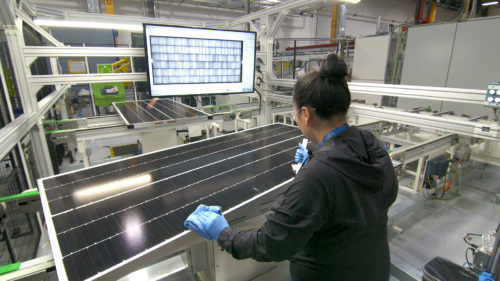In October 2018, SunPower acquired the SolarWorld Americas facility in Hillsboro, Oregon, making good on its commitment to invest in American manufacturing. Just four months later, SunPower is assembling its high-quality 19% efficient Performance Series solar panel (P19 or P-Series) for commercial customers in the U.S. factory, leveraging U.S.-made automated stringing equipment and a workforce of about 200.
 “Today we celebrate the revival of American solar panel manufacturing as SunPower’s high-quality P19 product starts coming off the line in Oregon,” said Tom Werner, SunPower CEO and chairman of the board. “Now that we’re in full production, we look forward to meeting our strong U.S. commercial market demand with these high-performance American-assembled panels.”
“Today we celebrate the revival of American solar panel manufacturing as SunPower’s high-quality P19 product starts coming off the line in Oregon,” said Tom Werner, SunPower CEO and chairman of the board. “Now that we’re in full production, we look forward to meeting our strong U.S. commercial market demand with these high-performance American-assembled panels.”
SunPower will begin fulfilling commercial customer orders and shipping P19 solar panels from Oregon in the coming weeks. SunPower’s P19 solar panel architecture leverages a unique cell interconnect technology developed by a U.S.-based company called Cogenra Solar and funded in part by the U.S. Department of Energy (DOE) SunShot Initiative. SunPower acquired Cogenra in 2015 and introduced P-Series solar panels that same year.
 Now made in several geographies, P-Series panels are currently the most deployed shingled cell solar panels in the world. For the second year running, DNV GL – a global independent energy expert and certification body – has named the P-Series solar panel a top performer in all five DNV GL tests that measured reliability through thermal cycling, damp heat, humidity-freeze, dynamic mechanical load and potential induced degradation.
Now made in several geographies, P-Series panels are currently the most deployed shingled cell solar panels in the world. For the second year running, DNV GL – a global independent energy expert and certification body – has named the P-Series solar panel a top performer in all five DNV GL tests that measured reliability through thermal cycling, damp heat, humidity-freeze, dynamic mechanical load and potential induced degradation.
“As a leading solar technology and energy services provider, we pride ourselves on offering the industry’s most efficient solar panels available today that we design, engineer and manufacture ourselves,” Werner continued. “With strong U.S. solar demand expected to continue, we are committed to offering our customers the option to buy industry-leading SunPower solar panels assembled right here at home.”
News item from SunPower




The claim is interesting, but I have found that there are “other” types of solar PV and cell architecture and chemistry that may prove more efficient over the life of the system. For instance the old Sanyo HIT solar PV panels were in the manufactured range of about 18% efficiency when produced way back in 2002. Sanyo fell victim to the Chinese push of their products onto the market place. It all came down to dollars. The Chinese produced solar PV panels were less efficient, but so much cheaper one could add two to four of the cheaper panels and “do” the same thing for less money spent. Sanyo fell and Panasonic picked up the intellectual property and continues to produce these panels. I have used the Sanyo (Panasonic) solar PV panels for 12 years and can say they performed above what I was told to expect. For instance, during those cloudy gray days when you can’t tell where the sun is, the panel array still averaged 8 to 10kWh of production a day. It doesn’t seem like much, but it did take care of my home’s energy needs for that particular day. One of the (Sanyo) claims was their panel made more power under low light conditions than the “other” solar panels on the market. With some of the claims of “future” PV panels being stacked by spraying on a coat of perovskite material can make a wider band width of the light spectrum useful for power generation. It very well may be possible to make a stacked solar PV cell that could convert up to 30% of the light into electricity. Then it gets interesting. First adopters may just remove their old system and sell them for pennies on the dollar on e-bay while putting in the “latest greatest” solar PV technology available on their roofs. This will create the situation of when Henry Ford fired up his manufacturing line and created automobiles that the average Joe could afford. After a few years there became a “used car market”. We will see such a market for used solar PV systems in the coming decades.